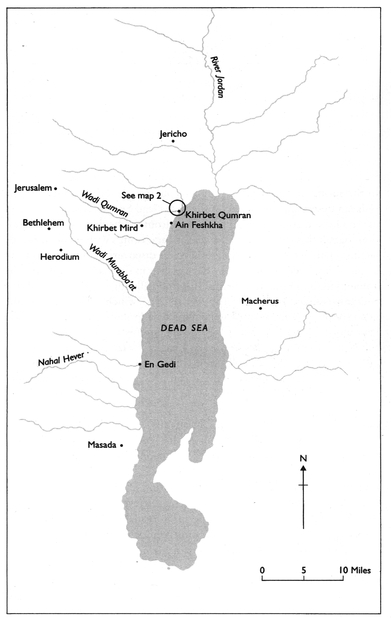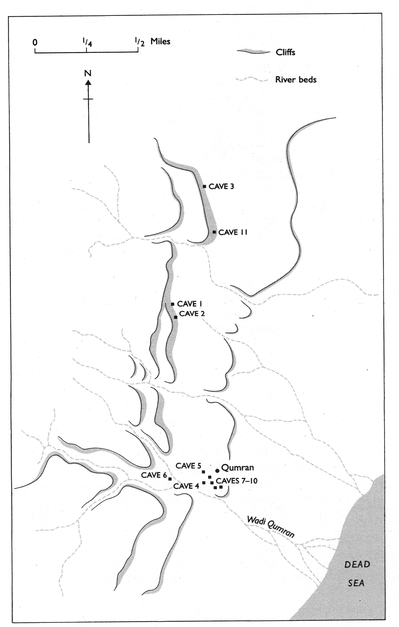Read The Complete Dead Sea Scrolls in English Online
Authors: Geza Vermes
The Complete Dead Sea Scrolls in English (2 page)

BOOK: The Complete Dead Sea Scrolls in English
6Mb size Format: txt, pdf, ePub
ads
Â
Maps drawn by Nigel Andrews
Â
The moral right of the author has been asserted
Â
Â
Â
eISBN : 978-1-101-16059-6
Â
Â

Penguin Books is committed to a sustainable future for our business, our readers and our planet.
The book in your hands is made from paper certified by the Forest Stewardship Council.
For M and I with love and in loving memory of P
Preface
In the spring of 1947 a young Arab shepherd climbed into a cave in the Judaean desert and stumbled on the first Dead Sea Scrolls. For those of us who lived through the Qumran story from the beginning, the realization that all this happened half a century ago brings with it a melancholy feeling. The Scrolls are no longer a
recent
discovery as we used to refer to them, but over the years they have grown in significance and now the golden jubilee of the first manuscript find calls for celebration with joy and satisfaction. Following the ârevolution' which âliberated' all the manuscripts in 1991 - until that moment a large portion of them was kept away from the public gaze - every interested person gained free access to the entire Qumran library. I eagerly seized the chance and set out to explore the whole collection. Today, after four and a half years of intense study, I feel confident that I can present the complete canvas of the Dead Sea Scrolls and disclose to the many interested readers the message of these ancient manuscripts about ancient Judaism and to a more limited extent about early Christianity.
recent
discovery as we used to refer to them, but over the years they have grown in significance and now the golden jubilee of the first manuscript find calls for celebration with joy and satisfaction. Following the ârevolution' which âliberated' all the manuscripts in 1991 - until that moment a large portion of them was kept away from the public gaze - every interested person gained free access to the entire Qumran library. I eagerly seized the chance and set out to explore the whole collection. Today, after four and a half years of intense study, I feel confident that I can present the complete canvas of the Dead Sea Scrolls and disclose to the many interested readers the message of these ancient manuscripts about ancient Judaism and to a more limited extent about early Christianity.
In its successive editions this book has endeavoured to serve a dual audience of scholars and educated lay people. Over the years it has grown in size - it contained only 255 pages in 1962 - and I trust also in its grasp of the subject. While this translation of the non-biblical Scrolls does not claim to cover every fragment retrieved from the caves, it is complete in one sense: it offers in a readable form all the texts sufficiently well preserved to be understandable in English. In plain words, meaningless scraps or badly damaged manuscript sections are not inflicted on the reader. Those who wish to survey texts consisting only of broken lines, or of single letters and half-letters, should turn to the official series
Discoveries in the Judaean Desert,
in which every surviving detail is put on record.
Discoveries in the Judaean Desert,
in which every surviving detail is put on record.
In addition to the English rendering of the Hebrew and Aramaic texts found in the eleven Qumran caves, two inscribed potsherds (ostraca) retrieved from the Qumran site and two Qumran-type documents discovered in the fortress of Masada, and brief introductory notes to each text, this volume also provides an up-to-date general introduction, outlining the history of fifty years of Scroll research and sketching the organization, history and religious message of the Qumran Community. A Scroll catalogue, an essential bibliography and an index of Qumran texts are appended to facilitate further study and research.

Map 1: The area surrounding the Dead Sea, showing Qumran

Map 2: The Caves of Qumran
Has the greatly increased source material substantially altered our perception of the writings found at Qumran? I do not think so. Nuances and emphases have changed, but additional information has mainly helped to fill in gaps and clarify obscurities; it has not undermined our earlier conceptions regarding the Community and its ideas. We had the exceptionally good fortune that all but one of the major non-biblical Scrolls were published at the start, between 1950 and 1956: the Habakkuk Commentary (1950), the Community Rule (1951), the War Scroll and the Thanksgiving Hymns (1954/5) and the best-preserved columns of the Genesis Apocryphon (1956). Even the Temple Scroll, which had remained concealed until 1967 in a Bata shoebox by an antique dealer, was edited ten years later. The large Scrolls have served as foundation and pillars, and the thousands of fragments as building stones, with which the unique shrine of Jewish religion and culture that is Qumran is progressively restored to its ancient splendour.
Finally, it is a most pleasant duty to express my warmest thanks to friends and colleagues who helped to make this book less imperfect than it might otherwise have been. First and foremost, I wish publicly to convey my gratitude to Professor Emanuel Tov, editor-in-chief of the Dead Sea Scrolls Publication Project, for his generosity in answering queries and assisting in every possible way. My very special thanks are due also to Professor Joseph M. Baumgarten, who allowed me to consult his edition of the Damascus Document fragments from Cave 4 prior to their publication in
DJD,
and to my former pupil, Dr Jonathan G. Campbell, who did not shirk the onerous task of reading through and commenting on the rather bulky printout of this volume.
DJD,
and to my former pupil, Dr Jonathan G. Campbell, who did not shirk the onerous task of reading through and commenting on the rather bulky printout of this volume.
G.V
Preface to the Penguin Classics edition
Since the end of 1996, when the text of
The Complete Dead Sea Scrolls in English
was sent to the printers, eighteen further tomes of manuscript material have appeared in the series
Discoveries in the Judaean Desert (DJD).
Today, in January 2003, only three more volumes, two biblical and one non-biblical, still await publication before the 39-volume venture, begun in 1955 with
DJD
I, reaches its fulfilment.
The Complete Dead Sea Scrolls in English
was sent to the printers, eighteen further tomes of manuscript material have appeared in the series
Discoveries in the Judaean Desert (DJD).
Today, in January 2003, only three more volumes, two biblical and one non-biblical, still await publication before the 39-volume venture, begun in 1955 with
DJD
I, reaches its fulfilment.
When reviewing
The Complete Dead Sea Scrolls
in 1997, John J. Collins wittily predicted: âIt is not inconceivable that a
more complete
edition may appear a few years hence.' Yet even today's revised and updated version remains in some way incomplete. It is without the scriptural texts found in the caves, which I never intended to include. Luckily these are now available in
The Dead Sea Scrolls Bible
issued by Martin Abegg, Peter Flint and Eugene Ulrich (Harper San Francisco, 1999). Neither have I attempted at any stage to present the English translation of every scrap devoid of significance (small, unconnected manuscript remains, broken sentences, single words, half-words or letters). However, I can state even more confidently than I did seven years ago that the reader will find in this volume all that is meaningful and interesting in the non-biblical Dead Sea Scrolls.
The Complete Dead Sea Scrolls
in 1997, John J. Collins wittily predicted: âIt is not inconceivable that a
more complete
edition may appear a few years hence.' Yet even today's revised and updated version remains in some way incomplete. It is without the scriptural texts found in the caves, which I never intended to include. Luckily these are now available in
The Dead Sea Scrolls Bible
issued by Martin Abegg, Peter Flint and Eugene Ulrich (Harper San Francisco, 1999). Neither have I attempted at any stage to present the English translation of every scrap devoid of significance (small, unconnected manuscript remains, broken sentences, single words, half-words or letters). However, I can state even more confidently than I did seven years ago that the reader will find in this volume all that is meaningful and interesting in the non-biblical Dead Sea Scrolls.
The introductory chapters and the bibliographies have also been brought up to date so that account is taken in them of all fresh material as well as of the continuous advance of Qumran research.
The publishers have decided to provide this book with a new niche: forty-one years after its first appearance in 1962 in the Pelican series, it will have its home from now on next to the great works of world literature in the Penguin Classics library.
I feel deeply honoured.
Â
Oxford, January 2003
G.V
Chronology



I. Introduction
On the western shore of the Dead Sea, about eight miles south of Jericho, lies a complex of ruins known as Khirbet Qumran. It occupies one of the lowest parts of the earth, on the fringe of the hot and arid wastes of the Wilderness of Judaea, and is today, apart from occasional invasions by coachloads of tourists, lifeless, silent and empty. But from that place, members of an ancient Jewish religious community, whose centre it was, hurried out one day and in secrecy climbed the nearby cliffs in order to hide away in eleven caves their precious scrolls. No one came back to retrieve them, and there they remained undisturbed for almost 2,000 years.
The account of the discovery of the Dead Sea Scrolls, as the manuscripts are inaccurately designated, and of the half a century of intense research that followed, is in itself a fascinating as well as an exasperating story. It has been told many a time, but this fiftieth anniversary of the first Scroll find excuses, and even demands, yet another rehearsal.
1
A BIRD'S-EYE VIEW OF FIFTY YEARS OF DEAD SEA SCROLLS RESEARCH1
1. 1947-1967

BOOK: The Complete Dead Sea Scrolls in English
6Mb size Format: txt, pdf, ePub
ads
Other books
Malakai by Michele Hauf
Web of Secrets (Agents Under Fire) by Susan Sleeman
The Geomancer's Compass by Melissa Hardy
Indelible by Woodland, Lani
Titus: Luna Lodge #2 by Stevens, Madison
(#20) The Clue in the Jewel Box by Carolyn Keene
Miracle in the Wilderness by Paul Gallico
Paper Tigers by Damien Angelica Walters
Camomile Lawn by Mary Wesley
The Catalyst (Targon Tales) by Reher, Chris